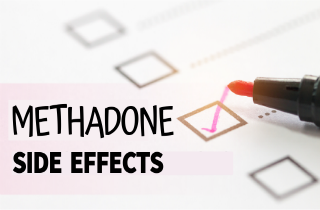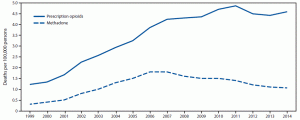ARTICLE OVERVIEW: Methadone is a synthetic narcotic. It is used legally to treat addiction to narcotics and to relieve severe pain. Main adverse side effects include sedation, respiratory problems, and sexual dysfunction. More on the PROs and CONs of this very controversial medication here.
TABLE OF CONTENTS
- Methadone Basics
- How It Works
- Onset
- Therapeutic Effect
- Short-Term Effects
- Long-Term Effects
- Side Effects
- Risks
- Abuse and Legal Issues
- Drugs to Avoid
- Signs of Overdose
- Your Questions
What Is Methadone?
Methadone is a synthetic, long-acting opioid with pharmacologic actions qualitatively similar to morphine. It is a synthetic opiate primarily used in the detoxification and maintenance of persons who are dependent on opiates and the treatment of persons with chronic, severe pain.
Methadone has been used for decades to treat people who are addicted to heroin and narcotic pain medicines. When taken as prescribed, it is safe and effective. It allows people to recover from their addiction and to reclaim active and meaningful lives. For optimal results, persons should also participate in a comprehensive medication-assisted treatment program that includes counseling and social support. [1]
How It Works
Methadone is active by oral and parenteral routes of administration. It works by changing how the brain and nervous system respond to pain. In particular, methadone, like other opioids, acts by engagement in cell surface opiate receptors (predominant µ type receptors). It is a controlled substance and classified as a Schedule II drug, indicating that it has medical usefulness, but also a high potential for physical and psychological dependency and abuse. In fact, use of methadone as a part of a medication assisted treatment program requires special certification.
In sum, methadone can lessen pain, delay symptoms of opiate withdrawal, and block the euphoric effects of opiate drugs such as heroin, morphine, and codeine, as well as semi-synthetic opioids like oxycodone and hydrocodone.
Onset
Methadone onset of action takes from 30-60 minutes with peak effects at 1-2 hours. Its effects Methadone is offered in pill, liquid, and wafer forms and is taken once a day. Pain relief from a dose of methadone lasts about four to eight hours. When used to treat narcotic addiction, methadone suppresses withdrawal symptoms for 24 to 36 hours and while the dose is highly individualized, maintenance doses are generally in the range of 20 to 120 mg daily. Review more information on the pharmacology of methadone in this Duke University Narcotics Analgesics video, Specific Analgesic Agents: Methadone…about minute 31:30. [2]
Therapeutic Effect
Methadone is used for both short-term pain relief and to stop cravings. When taking it, patients usually experience pain relief anywhere from 4-8 hours. However, it’s ability to cut cravings for stronger drug like heroin is a key reason it is used in detox and drug treatment programs. In fact, people who start taking methadone often continue taking it for at least 6 months for up to many years.
Methadone actually blocks the things that make people feel high from drugs like heroin and oxycodone. What is important to note with methadone, however, is that with proper dosages, the person taking methadone should not really feel “high.” Instead, s/he should feel normal and ready to function in the world.
Short-Term Effects
The short-term effects of methadone are similar to heroin, but less intense and longer lasting. Effects can last up to 24 hours, while heroin’s effects last approximately 2-3 hours. The effects of methadone can include the following:
- Drowsiness.
- Nausea.
- Feelings of euphoria.
- Pain relief.
- Relaxation.
- Respiratory depression.
- Sedation.
- Vomiting.
Furthermore, full pain relief is usually not attained until 3 to 5 days after you begin dosing. Indeed, the first 3 days on methadone are critical. Doctors are advised to monitor patients closely for respiratory depression, especially within the first 24 to 72 hours and to monitor or lower the dose carefully. Finally, because methadone has a long half-life and is known to be eliminated from the body slowly, risk of overdose exists.
Long-Term Effects
According to the Office of National Drug Control Policy, when methadone is taken under medical supervision, long-term maintenance causes no adverse effects to the heart, lungs, liver, kidneys, bones, blood, brain, or other vital body organs. Rather, the long-term effects can be positive. The long-term effects of methadone treatment include positive outcomes like:
- Better physical appearance.
- Better mood.
- Feeling healthy.
- Decreased incidents of blood born diseases like HIV or HCV infection.
- Improved appetite and weight gain.
- Increased social, work, and employment contriutions.
- Reduced cravings.
- Reduced drug use for heroin or other opiates.
However, the drug can cause discomfort. In this study, methadone maintenance patients reported jerk movement, frequent urination, dark urine and urinary retention, dizziness, headache and body pain when they were on methadone. [3] Long-term use has also been associated with impaired judgment, and it can lead to heart problems, just like other opiates. Other common long-term effects include:
- Constipation.
- Impaired judgment.
- Lowered sexual desire.
- Respiratory problems.
- Skin lesions.
Side Effects of Methadone
Side effects should be taken seriously, as some of them may indicate an emergency. Tell your doctor if any of these symptoms are severe or do not go away:
Difficulty falling asleep or staying asleep.
- Difficulty urinating.
- Dry mouth.
- Flushing.
- Headache.
- Mood changes.
- Sore tongue.
- Stomach pain.
- Vision problems.
- Weight gain.
Some side effects can be serious. If you experience any of the following symptoms, call your doctor immediately or get emergency medical help:
- Agitation.
- Confusion.
- Decreased sexual desire.
- Difficulty breathing or swallowing.
- Extreme drowsiness.
- Fast heartbeat.
- Fever.
- Hallucinations (seeing things or hearing voices that do not exist).
- Hives.
- Hoarseness.
- Inability to get or keep an erection.
- Irregular menstruation.
- Itching.
- Loss of coordination.
- Nausea, vomiting, loss of appetite, weakness, or dizziness.
- Nausea, vomiting, or diarrhea.
- Rash.
- Seizures.
- Severe muscle stiffness or twitching.
- Shivering.
- Sweating.
- Swelling of the eyes, face, mouth, tongue, or throat.
Methadone Risks
Methadone, as with many of the other most addictive prescription medications, is a potent Schedule II opioid pain medication. This means methadone addiction a very real possibility.
Overdose from methadone is a major concern and continues to be problematic in the U.S. Methadone overdoses are associated with severe respiratory depression, decreases in heart rate and blood pressure, coma, and death. In some instances, people who use other narcotics (such as heroin or OxyContin) turn to methadone because of its increasing availability. Methadone, however, does not produce the euphoric rush associated with those other drugs; thus, these users often consume dangerously large quantities of methadone in a vain attempt to attain the desired effect.
According to the CDC, methadone continues to account for nearly one in four prescription opioid-related deaths. In fact, we’ve seen the overall prescription opioid overdose death rate (involving natural and semisynthetic opioids and methadone) increase 300%, between 1999 and 2014…experts think that methadone prescribed for pain as well as for maintenance therapy is at the heart of this trend. [4] [5]
Misuse of methadone can also lead to problems. Because the effects are relatively similar to that of other opiates, it can be addictive on its own, even as it is used in the treatment of heroin dependence. Furthermore, mixing methadone with other substances that slow the body like alcohol and benzodiazepines increases the risk of breathing problems and death.
People who abuse methadone risk becoming tolerant (the body gets used to the presence of the drug, and needs higher doses of methadone), and physically dependent on the drug. When these persons stop using the drug they may experience withdrawal symptoms including muscle tremors, nausea, diarrhea, vomiting, and abdominal cramps.
Abuse and Legal Issues
Is abusing methadone illegal?
Yes, abusing methadone is illegal. Methadone, as we said above, is a Schedule II substance under the Controlled Substances Act. Schedule II drugs. Abuse of these drugs may lead to severe psychological or physical dependence. Abuse is considered:
- Taking methadone without a prescription.
- Taking methadone other than prescribed.
- Trying to alter methadone and snort, inject, or administer it to get high.
Drugs to Avoid
If you’re taking other medications, notify your prescribing doctor immediately. When mixed with other drugs, the chemicals can be dangerous to you. Why?
Methadone is metabolized by cytochrome P450 enzymes in the liver and selectively binds to mu opioid receptors. Medicinal products metabolized by these enzymes or competitors of mu receptors can modify the action of methadone, either decreasing it or increasing it, in the latter case it could be risky or even lacking for the person if it is not taken into consideration. These substances include:
Anti-epilepsy drugs, like phenytoin, that reduces blood levels of methadone by approximately 50% in 3 to 4 days. Other inducers of antiepileptic enzymes (phenobarbital, carbamazepine) increase the metabolism of methadone.
Anti-tubular drugs, like rifampicin, that reduces plasma levels of metadome, so the dose should be adapted. Rifabutin does not affect the kinetics of methadone.
Anti-viral drugs, like zidovudine, which in the presence of methadone increases the risk of undesirable effects.
Benzodiazepines mixed with methadone can be fatal due to respiratory depression.
Brupeofen is a methadone agonist in doses of 1 and 2 mg.
Chronic alcoholism reduces the area under the curve, while acute alcoholism increases it, enhancing the effects of methadone.
Fluvoxamine causes plasma levels of methadone increase from 20 to 100%.
Pure morphine agonists increase the risk of respiratory depression, while partial agonists promote the development of withdrawal symptoms.
Signs of Overdose
It is important to recognize the signs of methadone abuse as early as possible to prevent an addiction from developing. Likewise, you’ll need to recognize and treat signs of an overdose. Call 9-1-1 if you notice any of the following.
Symptoms of overdose may include the following:
- Cool, clammy, or blue skin.
- Drowsiness.
- Limp muscles.
- Loss of consciousness (coma).
- Slow or shallow breathing.
- Small, pinpoint pupils (black circles in the center of the eyes).
While the person are taking methadone, they may be told to always have a rescue medication called naloxone available at home or in your office. Naloxone is used to reverse the life-threatening effects of an overdose. It works by blocking the effects of opiates to relieve dangerous symptoms caused by high levels of opiates in the blood. [6]
Your Questions
Have you experienced any of these side effects? What other side effects have you heard about from people who are currently taking methadone? If you have any more questions about the methadone side effects, please leave your questions here. We try to respond to all legitimate questions with personal and prompt replies.












Related Posts